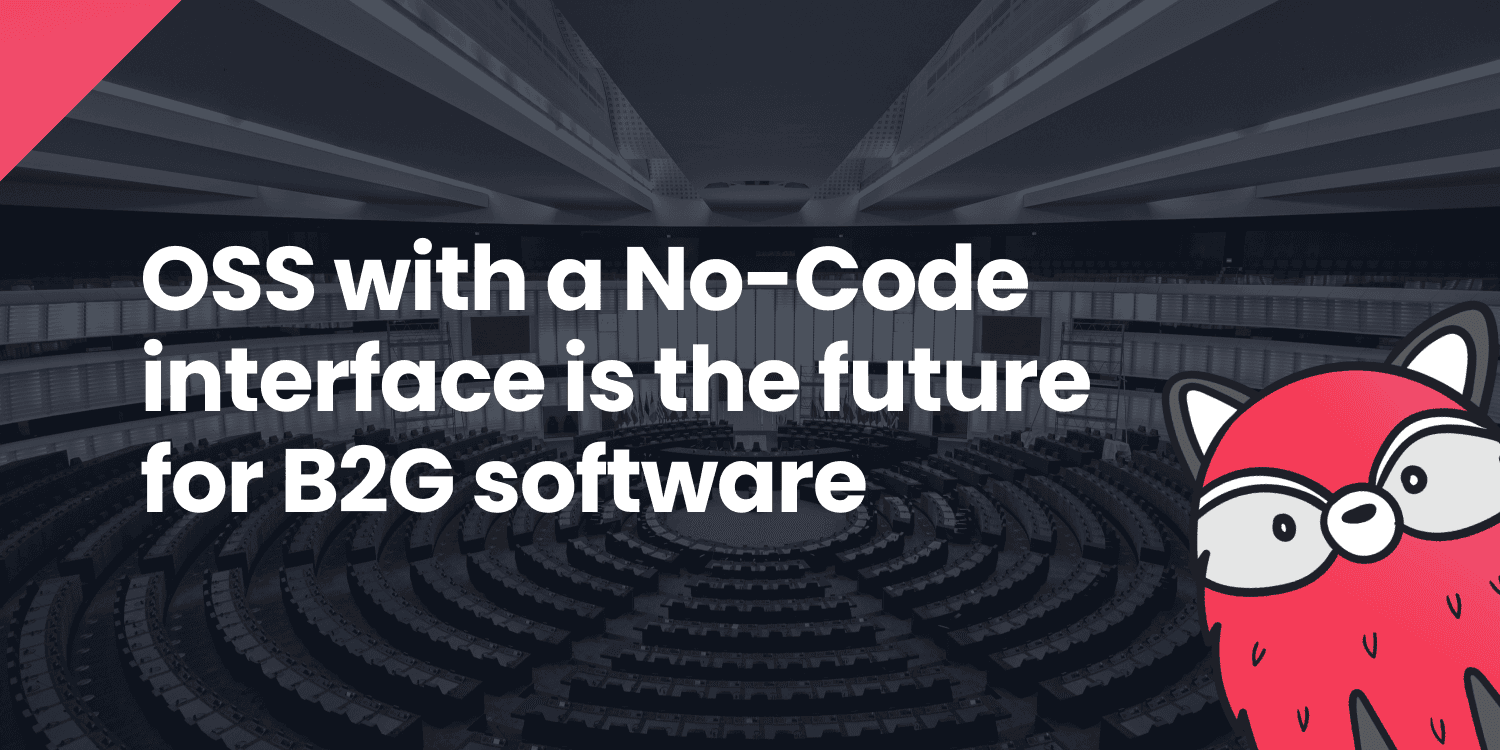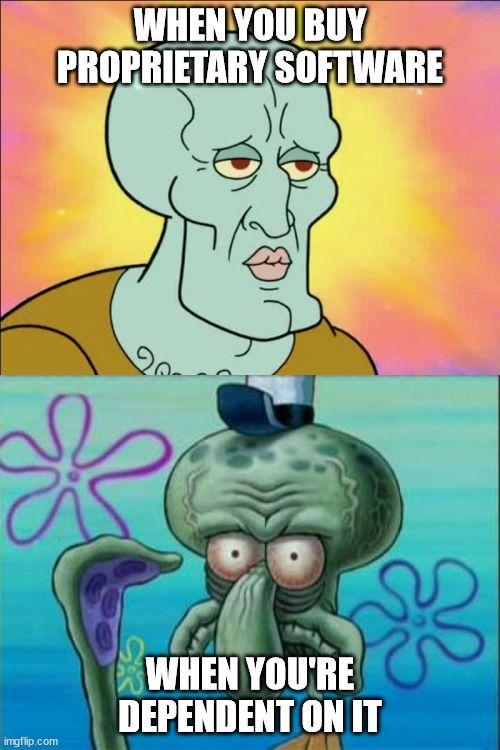Why Open-Source + No-Code is the Future of Enterprise & Goverment Software
Johannes
Co-Founder
4 Minutes
April 7th, 2023

Open source software (OSS) beats out proprietary software in every regard - except for value capturing. No-Code tools shorten the feedback loop between builders and consumers, kicking productivity through the roof. Here is why a no-code interface is cheatcode for OSS and why particularly large corporations and governments are to benefit the most.
Open source is so popular I'm surprised it's not dating a Kardashian
Don't be fooled that money makes the world go 'round, it's open source software. Your Mac and iPhone run on Unix, 4.7 billion Android devices run on Linux. Every single supercomputer runs on Linux, Google, Facebook, and Twitter run on Linux - you get the point. Or maybe not? 90% of the public cloud workload runs on Linux and SpaceX powers the Falcon Rocket with Linux.
Here is a pretty cringy cartoon of what the world would be without Linux:
Enough of Linux.
Proprietary software is like cable TV
You don't know exactly what you're getting and you're stuck with it when you don't want it anymore.
The idea of making and selling proprietary software is simple: If you cannot see the code of what you're buying, you're more dependent. With hundreds or thousands of employees involved and tools being deeply integrated into the tech infrastructure, the switching cost is too high. You're locked in.
The larger the organization gets, the more important it is that your tool stack is future-proof.
Enterprises & Governments are digging OSS
OSS doesn't have these restrictions. Unlike cable TV, you know exactly what you're getting, because the source code is openly accessible. If you are unhappy with the integrations built by the community or company developing the tool, you can build your own. OSS is the monthly subscription you can cancel once you binge watched the whole library. It's better for the consumer and this is why it's the winning model.

But no lock-in is only one key advantage, data ownership is equally important. In times of GDPR, CCPA, YMCA, etc. owning your data is essential to be fully compliant. Currently, there a lot of legal uncertainty for European institutions to use any SaaS tool where data flows to servers located in the United States. You can neither use Google Analytics nor Zapier. The solution, in many cases, is to neither analyze nor automate. Governmental institutions or larger companies cannot afford the reputational risk and attached fines of being exposed as non-compliant with privacy legislation.
In Germany, cities, municipalities and states have to choose the open source alternative, when there is one. In Europe, 49% of public institutions use OSS according to a survey from the University of Maastricht.
The Privacy Shield - which was the legal foundation for exchanging data between the US & EU - wasn't renewed because Data Processing Agreements were never meant to be a final solution. We need to rethink the approach to building technology to protect user data by design and reduce the power of data aggregators. The regulatory framework favours OSS already and will continue to do so in the long-term, which constitutes a significant competitive advantage for OSS.
Enough about OSS, let's talk about No-Code:
No-Code so popular it's a surprise it wasn't canceled yet
Well, maybe because everyone wins with No-Code on the rise. No-Code is compelling: It commoditizes code and it commoditizes design. It cuts straight to the core: providing value through functionality. The commoditization shortens the feedback loop between the builder and the user significantly, leading to faster iterations.
Funfact
No-Code is a facet of a trend that has been on-going for a while: Moving away from the gut feeling and
intuition of a few leaders to data-driven results of the many.
In the past a Don Draper kind of character decided which ad works best based on experience (and hubris). These
days every other social media manager runs 20 variations of an ad to get data on what actually works best. Enabling
people to no-code their own solutions shortens the feedback loop between decision-makers and consumers.
The beauty of No-Code is that every stakeholder gets something out of it, something different:
Why less-technical people ❤️ No-Code
- Non-engineers love No-Code tools because they can suddenly build everything they want. In the realms of web applications, there is almost nothing you cannot not build with Bubble.io. No-Code tools are extremely empowering.
- Furthermore, we can build much faster. Not having to find, vet and maybe pay a web developer, we can plug functionality from API-first tools together to test our ideas.
- This not only leads to better results but is extremely fulfilling. During my studies I built WordPress websites for smaller companies, always focussing on teaching the employees to manage and extend the website themselves (because I wanted to do other things with my time). Many of the people I worked with really enjoyed picking up a new skill boosting their self-efficacy. Happy employees, happy company.
Why devs ❤️ No-Code
- A huge advantage in larger teams is that devs can focus on tasks they enjoy. Much like I didn't like updating content on WordPress websites, most devs don't want to update content or fix typos in their web application: They want Jules from HR to fix the application form herself. No-Code allows them to do that. They implement a tool once and hand them over to the people working with them day in day out.
- Generally, a lot of devs love No-Code tools. Many prefer spinning up a tool with a user interface rather than the CLI because it requires less doc reading. Using No-Code tools can speed up the development significantly as they are less prone to cause bugs.
Why managers ❤️ No-Code
- Lastly, managers love No-Code tools. In short, because they deliver better results quicker. No-Code tools reduce the number of people involved in a process significantly. When you used to need a designer, a developer, a marketer and a set of customers to test a new idea, the marketer can get the job done alone. Design & engineering can be pulled in when the market demand is proven.
- This leads to much more efficient communication as every node of communication increases the amount of communication exponentially, and
- It leads to a reduced demand of engineers and designers, which are impossible to hire these days anyways. Overall, you can achieve better results quicker - for less money.
Open source + No-Code = 🔥
Let's look at the compound benefit of combining OSS with No-Code interfaces in larger organizations. We'll do so by looking at why everyone involved would want to use OSS or a No-Code interface. Let's start with the CTO:
CTO
Why the CTO digs OSS:
- No lock-in
- 100% Data Ownership
- No more tedious GDPR compliance checks & meetings
- fewer bugs and security risks because more people see and fix the code
Why the CTO digs No-Code:
- has happy engineers (see below)
- has to hire & manage less engineers
The Software Engineer
Why the Software Engineer digs OSS:
- Loves working with a modern tech stack
- Can check the code instead of opening support tickets
- Can build integrations
- Can hang with the community
- Can build public reputation with contributing to OS repo
Why the Software Engineer digs No-Code:
- Doesn't have to fix typos or update content
Everyone working with the tool
Why 'everyone' digs OSS:
- tbh they probably don't care too much
Why 'everyone' digs No-Code:
- Can build & update what they want
- Is less dependent on others
- Feels more self-efficacy
Overall, a pretty compelling offer, innit? Some closing thoughts 👇
The productivity & ownership boost is yet to come
The API-first approach of building products has lowered the barrier to be entrepreneurial significantly over the past 10ish years. It's much cheaper and easier to test your business idea, and many people make use of that.
This explosion of entrepreneurial spirit is yet to come within large organizations in the form of ownership & initiative (intrapreneurship). To this day, they're restricted by data privacy compliance and missing integrations for the legacy stack the organization maintains. Offering them OSS with a No-Code interface is the key to unlock their potential.
Your proprietary code is my opportunity.
The OSS Renaissance is in full swing. The argument laid out above is just one of many reasons why we are so excited to build in this space. Others are composability, communal effort or the ratio of value creation vs. value capture - but these are topics for other articles.

Finally good open source forms
We're developing an open source Typeform alternative to solve all form needs - from indie hackers to governments. Forms are an essential pillar of web infrastructure and yet there is no comprehensive open source form tool. We're changing that.
Sources
100% of super computers run Linux
49% of public institutions use OSS
New Privacy Shield not before EOY 22
Comparison Article: Free VPN for iPhone
Try Formbricks now


